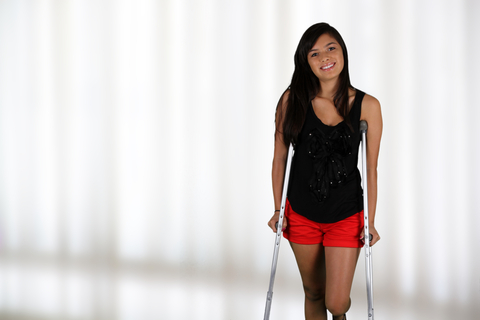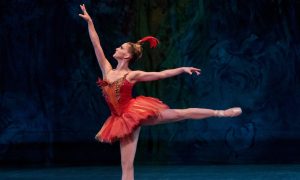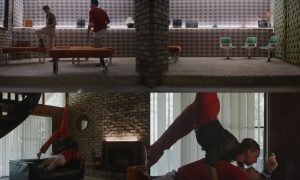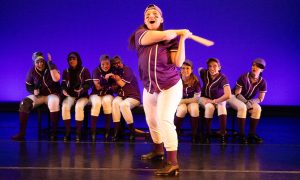By Leah Gerstenlauer.
Dance is a powerful drug. At best, it inspires adventurous bravery and euphoria, propelling artists to achieve incredible physical feats. But every drug has its downside, and in dance, one enormous risk is injury — the inevitable discovery that invincibility is merely a myth.
Five professional dancers from around the country recently shared their stories of injury with Dance Informa. With their careers back on track, all of these artists are more determined than ever to keep themselves strong, safe, and healthy in an industry laden with pressure to perform.
Disasters and Diagnoses
Sometimes, an injury is just an injury — an isolated incident that can alter the course of a career. Marshall Ellis was performing a soloist role in Orlando Ballet’s production of Don Quixote when he hit the ground. “An MRI showed a tear in my cartilage the size of a nickel, which I had stem cell surgery to repair. As a male dancer performing so many jumps and tricks, accidents can happen.”
But for many dancers, injury is progressive, stemming from overwork, improper training, or genetic traits that clash with the physical demands of dance. Ashley Flaner of California-based company Post:Ballet had wrestled with lower back pain for years when she was literally floored by a collision of spinal conditions. “During American Ballet Theatre’s summer program, I was on the floor stretching and something snapped. I couldn’t move for an hour. The doctor told me I’d fractured L4 and L5, had a bulging disc, had degenerative disc syndrome… The pain was excruciating, from the crown of my head to my feet.”
When New York City Ballet’s Megan Johnson was diagnosed with a similar condition — a bulging disc between L5 and S1 — she was told that she had probably been working with the condition since she joined NYCB over two years earlier. “Specialists believe it came about because I was being overworked while I was still growing. At first, my symptoms consisted mostly of tightness and tension down my legs, but ultimately, the disc area became so inflamed that I couldn’t relevé.”
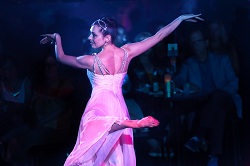
Stephanie Wolf dancing with Ballets With a Twist. Photo by Joseph Zummo.
Stephanie Wolf’s career with Ballet Nouveau Colorado had barely begun when a severely torn hip ligament and a spiral fracture in her right femur sent her to the sidelines. “I danced on a broken leg for almost a month. One Saturday before a show, we did a run-through, and my partner had to pick me up from the ground because I couldn’t stand. My specialist said that if I had performed, I probably would have walked with a limp for the rest of my life.”
Former Miami City Ballet member Maira Barriga also grappled with a multi-dimensional injury, the full extent of which emerged only after several years and countless visits to doctors. “It started with pain and clicking in my ankle every time I went up and down on pointe. Finally, the pain [a symptom of inflamed tendons and ligaments] was too intense to mask. I was basically dislocating my foot every time I went on pointe.”
The Long and Winding Road to Recovery
For all five dancers, the prospect of taking time off to recuperate was terrifying, especially given little assurance of when they could resume their normal lives. Megan was out for 14 months, during which time she tried to focus on every possible positive. “I applied to Columbia University and took a class, I spent more time with family and friends… and I met my boyfriend.” For her treatment, she relied on the specialized team at Westside Dance Physical Therapy, where she began decompression and stabilization exercises that she still practices each day.
Stephanie feels fortunate that Ballet Nouveau offers exceptional workman’s comp. She has seen an orthopedist, a hip specialist, and even a sports nutritionist to ensure that her body is absorbing nutrients properly. As to taking it easy on herself while in recovery — well, that has been more of a struggle. “I sat on the couch for a week and a half, which I’ve never done before. This has been an incredibly humbling process. But as my body is healing, I’m becoming calmer and more positive.” And as a journalist for Dance Informa and cofounder of the dance blog DIYdancer, Stephanie gleaned comfort from alternative creative outlets.
Still suffering after two surgeries, Maira explored less invasive options in her home country, Japan. Combining the advice of her massage and physical therapists, she happily evaded a third operation. “They helped me understand what went wrong, giving me exercises specific to my condition. Slowly, the pain diminished and my foot got stronger.” For this dancer, dabbling in life off the marley actually proved to be an enjoyable adventure. “I moved to New York, made awesome non-dancer friends, and worked a bunch of odd jobs. I missed dancing a lot, but that ‘normal’ lifestyle was pretty interesting!”
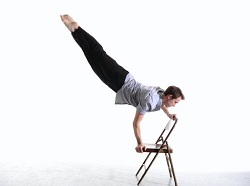
Dancer Marshall Ellis. Photo by Michael Cairns.
With no health insurance and little workman’s comp, Marshall, too, found himself taking charge of his own recovery. “For two weeks, I was on my couch with a machine moving my leg for me. It was the hardest time in my life. I attended only two physical therapy appointments. The rest I did on my own.” In spite of his dwindling finances and lack of support, Marshall proudly made a comeback after only nine months.
Though Ashley was lucky enough to have insurance, her real recovery began when she chose to finish her last year in the dance program at the University of California, Irvine. “I saw about six doctors and they all said, ‘You need to stop dancing. You can’t make a career out of this.’ But the dance department showed complete support. The kinesiology and body conditioning staff took me under their wings, giving me Feldenkrais and Pilates exercises. I did as much ballet as I could, and by November, I was dancing full out with the program again.”
Fresh Starts and Wise Words
Post-injury, each dancer holds new appreciation for and wisdom about the art and the physical act of dance. Marshall’s tenacity has driven his career to new heights, and in several new directions. He eventually left Orlando Ballet of his own volition and landed principal contracts in The Lion King at Disney World and with Cirque du Soleil. Marshall also launched his own media design business and a contemporary dance company, ME Dance. He maintains that, even in the face of injury and a daunting recovery process, “no one can stop you but yourself. Hard work and determination really do pay off.”
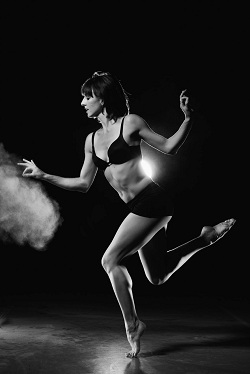
Ashley Flaner dancing for Post:Ballet. Photo by David DeSilva.
Ashley internalized a comparable philosophy, and upon graduating from UCI, secured a contract with San Francisco’s Company C. She also continued to explore the body conditioning techniques she had learned while fighting her way back to health, eventually embarking on a dual career as dancer and certified Pilates instructor. “After Company C, I started working with Robert Dekker and Post:Ballet. I can use my Pilates training for his grounded and sliding movement — my body feels so good working with him.” Her advice: “To avoid injury, you have to know your anatomy and build strength within your alignment. And if you do get injured, know that you’ll be wiser for it.”
Stephanie, whose injury has fueled her double-pronged career in dance and writing, is taking her own notes on self-empowerment, and learning that personal limits are not equivalent to insurmountable faults. “We’re not just artists; we’re artists and athletes. We need to acknowledge that it’s not always smart to push through pain.” When she returned to Ballet Nouveau last month, she entered the studio with a heightened awareness of her own remarkable, but undeniably human capabilities.
Upon her return to NYCB, Megan carried an increased sensitivity to her body and a firm commitment to creating a sustainable career for herself. “My injury is chronic, so I’m still learning new ways to manage my symptoms. Each week, I go to PT, in addition to getting massage and acupuncture. I wake up an hour early every morning to do my stabilization exercises, and I still decompress a few times a day.” Her routine is an enormous undertaking, but Megan knows the worth of her efforts. “Injury really tests your passion and resolve to dance… I’m so thankful I stuck it out.”
As for Maira, the future is bubbling with possibilities now that she is back in the studio every day. As she dives into audition season, she continues to follow her own treatment regimen, faithfully adhering to the simple systems that guided her back to wellness. “It’s hard to feel totally ready to work again — especially when so many doctors told me to stop dancing. I had my mother telling me not to give up. For those who don’t have someone pushing them forward, know that though there is no easy way out of injury, we are so much more resilient than we think.”
For more dancer-friendly injury information and advice, visit the Harkness Center for Dance Injuries website at http://hjd.med.nyu.edu/harkness/.
Photo (top): © Rmarmion | Dreamstime.com


